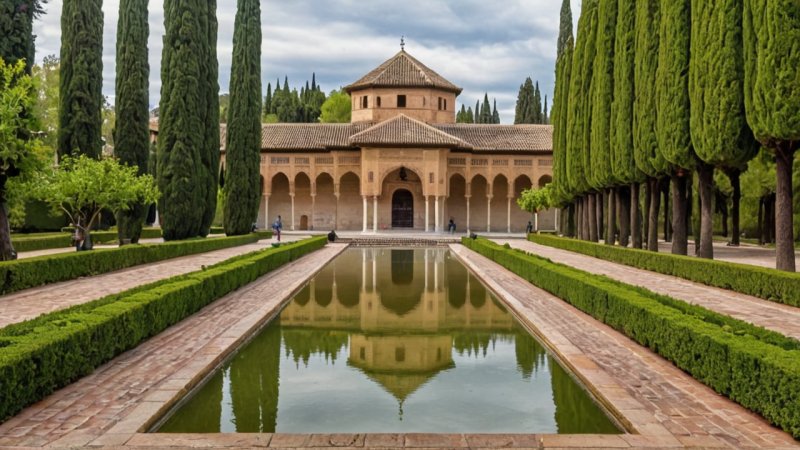The Alhambra, a stunning architectural marvel nestled in the hills of Granada, Spain, stands as a testament to the incredible cultural fusion that characterized the region during the medieval period. This UNESCO World Heritage site not only captivates visitors with its breathtaking beauty but also offers a glimpse into the rich history and artistry of Islamic architecture. As you stroll through its intricate palaces, lush gardens, and imposing fortifications, you will discover how the Alhambra embodies a harmonious blend of artistry, spirituality, and nature, making it a unique experience for travelers seeking to explore the depths of Spain’s cultural heritage.
A Brief History of the Alhambra
The Alhambra's origins trace back to the 9th century when it was initially constructed as a modest fortress. However, it was in the 13th century, under the Nasrid dynasty, that the Alhambra evolved into a magnificent palace complex. The Nasrids were known for their exceptional architectural skills, and they transformed the Alhambra into a symbol of power and beauty. Over the centuries, the site has witnessed many changes, including its conversion into a royal palace for the Catholic Monarchs following the Reconquista in 1492. Each era left its mark on the Alhambra, contributing to its unique architectural style that reflects a blend of Islamic, Renaissance, and Moorish influences.
The Architectural Features of the Alhambra
One of the most striking aspects of the Alhambra is its intricate architectural details. As you explore the complex, you'll encounter a variety of styles and elements that showcase the craftsmanship of its builders. Here are some key features:
- Islamic Calligraphy: The walls of the Alhambra are adorned with verses from the Quran, showcasing exquisite calligraphy that enhances the spiritual atmosphere of the site.
- Geometric Patterns: The use of intricate geometric patterns is a hallmark of Islamic architecture and is abundantly present in the Alhambra. These designs symbolize the infinite nature of creation and reflect the unity of the universe.
- Stucco Work: The delicate stucco ornamentation found throughout the Alhambra is a testament to the artistry of the craftsmen. The intricate designs often feature floral and arabesque motifs, adding to the aesthetic appeal.
- Water Features: Water plays a crucial role in the design of the Alhambra, symbolizing purity and life. The sound of flowing water can be heard throughout the gardens and courtyards, contributing to a serene atmosphere.
- Courtyards and Gardens: The Alhambra boasts several stunning courtyards, such as the famous Patio de los Leones, which features a central fountain surrounded by twelve stone lions. The Generalife, a summer palace with lush gardens, offers breathtaking views of the Alhambra and the surrounding mountains.
Must-See Areas of the Alhambra
When visiting the Alhambra, there are several areas that you simply cannot miss. Each location offers a unique perspective on the architectural brilliance of this historic site:
- Palacios Nazaríes (Nasrid Palaces): The heart of the Alhambra, these palaces are renowned for their stunning interiors and intricate decoration. Don't miss the impressive Salón de los Embajadores (Hall of the Ambassadors) and the enchanting Patio de los Arrayanes.
- Alcazaba: This fortress offers breathtaking panoramic views of Granada and the Sierra Nevada mountains. Climbing the towers provides a sense of the Alhambra's historical significance as a defensive structure.
- Generalife: The summer palace and gardens of the Nasrid rulers, Generalife is a tranquil oasis filled with beautiful flora, fountains, and stunning views of the Alhambra itself.
- Palacio de Carlos V: This Renaissance palace, built in the 16th century, contrasts sharply with the Islamic architecture of the Alhambra. Its circular courtyard is a must-see and highlights the architectural evolution of the site.
Travel Tips for Visiting the Alhambra
To make the most of your visit to the Alhambra, here are some practical tips:
- Book in Advance: Due to its popularity, tickets for the Alhambra can sell out quickly. It’s advisable to book your tickets online in advance, especially during peak tourist seasons.
- Guided Tours: Consider taking a guided tour to gain insights into the history and architecture of the Alhambra. Knowledgeable guides can enhance your experience with fascinating stories and details.
- Wear Comfortable Shoes: The Alhambra covers a large area with many uneven surfaces. Comfortable walking shoes are a must to navigate the grounds.
- Visit Early or Late: To avoid crowds, plan your visit early in the morning or later in the afternoon. The softer light during these times also enhances the beauty of the architecture.
- Take Your Time: Don’t rush through your visit. Take your time to soak in the beauty and serenity of the surroundings, and don’t forget to explore the gardens and viewpoints.
Unique Experiences Nearby
While the Alhambra is undoubtedly the highlight of any visit to Granada, the surrounding area offers additional unique experiences. Consider exploring the following:
- Albayzín: This historic neighborhood, with its narrow winding streets and whitewashed houses, offers a glimpse into Granada's Moorish past. The views of the Alhambra from the Mirador de San Nicolás are particularly stunning.
- Sacromonte: Known for its cave dwellings and flamenco shows, Sacromonte offers a unique cultural experience. Visiting a traditional cave house can provide insights into the local way of life.
- Local Cuisine: Don’t miss out on trying traditional Andalusian dishes such as tapas, paella, and local wines. Granada is renowned for its free tapas culture, where you receive a complimentary dish with your drink.
The Alhambra is more than just a monument; it is a living canvas of history, culture, and artistry. Its unique architecture, breathtaking gardens, and rich history invite travelers to immerse themselves in the beauty of Spain’s past. From the intricate details of the Nasrid Palaces to the serene landscapes of the Generalife, every corner of the Alhambra tells a story waiting to be discovered. As you plan your visit, remember to take your time and savor the experience, for the Alhambra is a treasure that deserves to be explored in depth.






